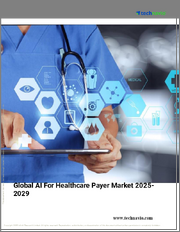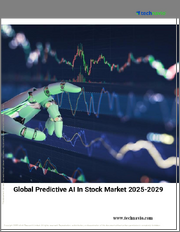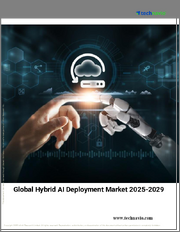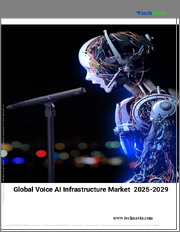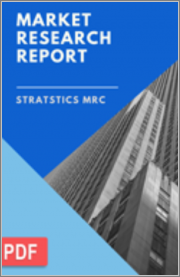
|
시장보고서
상품코드
1358973
헬스케어용 인공지능(AI) 시장 예측(-2030년) : 오퍼링별, 기술별, 용도별, 최종사용자별, 지역별 세계 분석Artificial Intelligence in Healthcare Market Forecasts to 2030 - Global Analysis By Offering, Technology, Application, End User and By Geography |
||||||
Stratistics MRC에 따르면 세계의 헬스케어용 인공지능(AI) 시장은 2023년에 224억 2,000만 달러를 차지하며 예측 기간 중 CAGR은 45.6%로 성장하며, 2030년에는 3,110억 4,000만 달러에 달할 것으로 예측되고 있습니다.
인공지능(AI)은 복잡한 의료 데이터를 분석하기 위해 알고리즘과 소프트웨어를 사용하는 것을 포함하며, 추론, 학습, 문제 해결 능력 등 인간의 지능에 기반한 다양한 기능을 생물학, 컴퓨터 과학, 수학, 언어학, 심리학, 공학 등 다양한 분야에 응용한 지능형 시스템으로 정의됩니다. 헬스케어 분야에서의 AI 활용은 의료 연구개발의 효율성, 창의성, 비용 효율성을 향상시키고 있습니다.
2020년 NCBI의 연구에 따르면 AI 기반 알고리즘은 의료 전문가가 음성으로 진단한 25명의 환자 데이터 세트에서 COVID-19 양성 사례의 68%를 정확하게 식별했습니다.
정부와 민간부문의 투자
PwC에 따르면 인공지능(AI)은 효과적이고 신속하게, 그리고 훨씬 저렴한 비용으로 운영 작업을 수행하기 때문에 제약 및 의료 기술 기업이 비즈니스 성장을 위해 인공지능(AI)에 대한 지출을 늘리면서 이 산업이 빠르게 확장될 것으로 예상됩니다. 또한 AI는 모든 질병의 조기 발견과 진단에 있으며, 의료 종사자를 돕습니다. 그 결과, 대부분의 의료 서비스 프로바이더들이 이 사업에 대한 투자를 늘리고 있습니다.
비용 상승, 데이터 유출, 복잡성 증가
인공지능(AI)의 의료 산업에서의 응용 사례는 많지만, 아직 보급률은 상대적으로 낮습니다. 의료 서비스 프로바이더는 몇 가지 복잡한 문제를 해결해야 하기 때문입니다. 인공지능의 통합은 오류를 유발하고 환자의 진단과 제공된 약품 사이에 단절을 초래할 수 있습니다. 데이터에 대한 프라이버시 문제도 의료 분야에서 인공지능의 장애물이 되고 있습니다. 많은 국가에서 환자의 건강 정보를 보호하는 특정 법률이 시행되고 있습니다. 그러나 이 규제를 어길 경우 금전적, 법적 처벌을 받을 수 있습니다. 또한 기밀 데이터의 비윤리적 수집과 같은 문제로 인해 환자 데이터 보안에 대한 위험도 증가합니다. 이로 인해 환자 안전과 비윤리적 데이터 수집에 대한 우려가 높아져 전체 시장 확대에 걸림돌로 작용하고 있습니다.
대규모의 복잡한 헬스케어 데이터 세트의 개발
빅데이터라고도 불리는 대규모의 복잡한 데이터는 클릭 스트림, 웹 및 소셜미디어에서의 상호 작용, 심전도(ECG), 엑스레이, 펄스옥시미터 등 의료기기 판독값, 의료비 청구 등 진료비 청구 기록, 전자의무기록(EMR), 투약, 생체 데이터 등으로부터 수집된 정보를 식별하기 위해 헬스케어 분야에서 사용되고 있습니다. 지난 10년간 의료진이 전자의무기록(EHR), 디지털화된 검사 슬라이드, 고해상도 방사선 영상 등을 도입하면서 빅데이터 수집 및 분석 툴의 개발이 비약적으로 발전해 널리 활용되고 있습니다.
AI 인력 부족과 불충분한 전자 의료 소프트웨어 규제 기준
AI는 복잡한 시스템이기 때문에 기업은 AI 시스템을 설계, 관리, 도입하기 위해 특정 기술을 가진 인재가 필요합니다. 예를 들어 AI 시스템을 다루는 개인은 딥러닝, 인지 컴퓨팅, ML, 머신 인텔리전스 등의 기술에 능숙해야 합니다. 하지만 인간의 뇌의 행동을 재현하고 AI 솔루션을 기존 시스템에 통합하는 것은 상당한 데이터 처리가 필요한 어려운 작업입니다. 작은 실수라도 시스템 오작동을 유발하거나 원하는 결과에 부정적인 영향을 미칠 수 있습니다.
COVID-19의 영향:
분석 기간 중 COVID-19의 영향으로 헬스케어 분야의 인공지능(AI) 시장이 크게 성장할 것으로 예상됩니다. 바이러스 확산을 모니터링하여 COVID-19를 진단하는 AI의 능력으로 인해 AI 기반 툴 및 솔루션에 대한 수요가 크게 증가하고 있습니다. 또한 주민의 전염병 위험 평가를 분석하고 실시간 데이터를 수집하는 데 사용되는 EHR(Electronic Health Record) 시스템에 대한 수요 증가도 시장 확대에 기여하고 있습니다.
예측 기간 중 소프트웨어 분야가 가장 큰 비중을 차지할 것으로 예상
예측 기간 중 소프트웨어 부문은 인공지능 기반 소프트웨어 솔루션이 의료 기관, 의료 종사자, 소비자 및 지불인에게 빠르게 확산되면서 가장 큰 시장 점유율을 차지했습니다. 소프트웨어 부문의 성장에는 헬스케어 산업에서 AI 기반 소프트웨어 솔루션 활용을 위한 투자 증가가 기여했습니다. 또한 이러한 성장은 세계에서 다양한 헬스케어 용도에서 AI 및 머신러닝 기반 기술의 활용이 증가하고 있는 것과도 관련이 있습니다.
제약 및 생명공학 기업 부문은 예측 기간 중 가장 높은 CAGR을 기록할 것으로 예상됩니다.
제약 및 생명공학 기업 부문은 예측 기간 중 유리한 성장세를 보일 것으로 추정됩니다. 헬스케어 분야에서 인공지능(AI)은 유전자 염기서열 분석 작업을 지원하고 의약품의 치료 효과와 안전성을 예측하는 데 활용되고 있습니다. 이 시장 영역의 확대는 다양한 시장 참여자들 간의 파트너십 증가로 인해 촉진되고 있습니다. 예를 들어 Merck KGaA와 Janssen Pharmaceuticals, N.V.는 2020년 7월 공동으로 AI 진단 툴을 개발했습니다. 이 기술은 소외된 열대성 질병(NTDs)인 주혈흡충증과 토양전염성 기생충증(STH)을 더 잘 감지할 수 있도록 도와줍니다.
가장 큰 점유율을 차지하는 지역 :
아시아태평양은 급속한 IT 인프라 구축과 AI 기반 기술에 특화된 기업이적 프로젝트로 인해 외삽 기간 중 가장 큰 점유율을 차지할 것으로 예상됩니다. 치료 결과, 데이터 분석, 보안 개선, 비용 절감을 목적으로 하는 개인 투자자, 벤처 캐피탈 및 비영리 단체의 투자 증가로 인해 채택률이 증가하고 있습니다. 또한 아시아태평양 시장의 성장을 가속하는 주요 이유 중 하나는 의료 기관과 의료 서비스 프로바이더가 AI 기반 기술을 신속하게 도입할 수 있도록 지원 및 촉진하는 정부의 우호적인 정책입니다.
CAGR이 가장 높은 지역 :
최첨단 디지털 기술에 대한 수요가 증가함에 따라 북미는 예측 기간 중 수익성 높은 성장을 이룰 것으로 예상됩니다. 북미는 의료, IT 및 통신 인프라가 견고하고 발달되어 있으며, 의료 분야의 인공지능(AI) 시장이 확대되고 있습니다. 또한 이 지역의 헬스케어 산업은 첨단 디지털 기술 활용을 촉진하는 정부 규제에 힘입어 성장세를 보이고 있습니다. 북미에는 방대한 환자 풀이 있습니다. 미국 인구의 절반 이상이 하나 이상의 만성질환을 앓고 있는 것으로 추정됩니다. 이에 따라 이 지역 병원의 환자 수가 증가하고 있습니다.
무료 커스터마이즈 서비스 :
이 리포트를 구독하는 고객은 다음 무료 커스터마이즈 옵션 중 하나를 이용할 수 있습니다. :
- 기업 개요
- 추가 시장 기업의 종합적 프로파일링(최대 3사)
- 주요 기업의 SWOT 분석(최대 3사)
- 지역 세분화
- 고객의 관심에 따른 주요 국가의 시장 추산·예측·CAGR(주 : 타당성 체크에 따름)
- 경쟁 벤치마킹
- 제품 포트폴리오, 지리적 입지, 전략적 제휴에 기반한 주요 기업의 벤치마킹
목차
제1장 주요 요약
제2장 서문
- 개요
- 이해관계자
- 조사 범위
- 조사 방법
- 데이터 마이닝
- 데이터 분석
- 데이터 검증
- 조사 어프로치
- 조사 소스
- 1차 조사 소스
- 2차 조사 소스
- 전제조건
제3장 시장 동향 분석
- 촉진요인
- 억제요인
- 기회
- 위협
- 기술 분석
- 애플리케이션 분석
- 최종사용자 분석
- 신흥 시장
- 신종 코로나바이러스 감염증(COVID-19)의 영향
제4장 Porter's Five Forces 분석
- 공급 기업의 교섭력
- 구매자의 교섭력
- 대체품의 위협
- 신규 진출업체의 위협
- 경쟁 기업간 경쟁 관계
제5장 세계의 헬스케어용 인공지능(AI) 시장 : 오퍼링별
- 하드웨어
- 메모리
- 통신망
- 프로세서
- 소프트웨어
- AI 솔루션
- AI 플랫폼
- 서비스
제6장 세계의 헬스케어용 인공지능(AI) 시장 : 기술별
- 자연언어처리
- 패턴과 영상 인식
- 분류와 분류
- 음성 분석
- 기타
- 기계학습
- 강화학습
- 지도형
- 딥러닝
- 기타
- 컴퓨터 비전
- 기타
제7장 세계의 헬스케어용 인공지능(AI) 시장 : 애플리케이션별
- 사이버 보안
- 헬스케어 지원 로봇
- 응급실과 수술
- 라이프스타일 관리와 모니터링
- Drug Discovery
- 의료용 영상 및 진단
- 기타
제8장 세계의 헬스케어용 인공지능(AI) 시장 : 최종사용자별
- 환자
- 제약 및 바이오테크놀러지 기업
- 헬스케어 지불자
- 기타
제9장 세계의 헬스케어용 인공지능(AI) 시장 : 지역별
- 북미
- 미국
- 캐나다
- 멕시코
- 유럽
- 독일
- 영국
- 이탈리아
- 프랑스
- 스페인
- 기타 유럽
- 아시아태평양
- 일본
- 중국
- 인도
- 호주
- 뉴질랜드
- 한국
- 기타 아시아태평양
- 남미
- 아르헨티나
- 브라질
- 칠레
- 기타 남미
- 중동 및 아프리카
- 사우디아라비아
- 아랍에미리트
- 카타르
- 남아프리카공화국
- 기타 중동 및 아프리카
제10장 주요 발전
- 계약, 파트너십, 협업, 합병사업
- 인수합병
- 신제품 발매
- 사업 확대
- 기타 주요 전략
제11장 기업 개요
- Alphabet Inc
- Butterfly Network, Inc
- Cyrcadia Health Inc
- DeepMind Technologies Limited
- Enlitic Inc
- General Vision
- IBM Corporation
- Intel Corporation
- Microsoft Corporation
- Next IT Corp.
- Nuance Communications, Inc
- NVIDIA Corporation
- Sophia Genetics
- Welltok Inc.
- Zebra Medical Vision Ltd
According to Stratistics MRC, the Global Artificial Intelligence in Healthcare Market is accounted for $20.87 billion in 2023 and is expected to reach $175.00 billion by 2030 growing at a CAGR of 35.5% during the forecast period. Artificial intelligence (AI) is defined as the study of intelligent agents, i.e., any agent or tool that has the ability to comprehend and grasp its environment and, as a result, to determine the appropriate course of action to increase its chances of succeeding. AI also refers to situations in which machines can mimic the learning and problem-solving processes of the human brain.
According to the statistics published by the CI security, data breaches in the healthcare industry increased by around 36.0% in the second half of 2020. This revealed that around 21.3 million patient records were hampered.
Market Dynamics:
Driver:
Growing healthcare data
Electronic health records, medical equipment, wearable sensors, and genomics are just a few of the sources of the data explosion in the healthcare sector. This flood of data contains a wealth of insights that AI is just beginning to unlock. Moreover, AI algorithms can make predictions, find hidden patterns in this data, and assist healthcare professionals in making decisions that are supported by the best available evidence.
Restraint:
Data security and privacy issues
Data security and privacy are of utmost importance in the healthcare industry because of the sensitive patient data that is handled there. Additionally, an increased risk of data breaches, which could potentially harm patients and have legal repercussions, exists as AI systems become more dependent on access to large volumes of patient data. It's difficult to balance providing AI with access to data while maintaining strict data security protocols.
Opportunity:
Remote monitoring and telemedicine
AI facilitates the growth of telemedicine and remote patient monitoring, which have become more popular, particularly during the COVID-19 pandemic. Furthermore, AI-powered virtual healthcare platforms make it possible to manage chronic diseases, monitor symptoms, and conduct remote consultations, ensuring continuity and accessibility of care, especially for people living in rural or remote areas.
Threat:
Threats to data privacy and security
Healthcare organizations are attractive targets for cyber attacks as they gather enormous amounts of private patient data. Patient confidentiality may be violated, patient records may be compromised, and identity theft may occur as a result of data breaches and security breaches. However, to lessen these risks, it is essential to maintain strong data security procedures, encryption, and regulatory compliance.
COVID-19 Impact:
The COVID-19 pandemic has significantly altered healthcare priorities and accelerated the adoption of technology, including artificial intelligence. Increased investments in AI-driven solutions for telemedicine, vaccine development, drug discovery, and pandemic response followed the pandemic's emphasis on the value of effective healthcare delivery, remote monitoring, and quick diagnostics. Moreover, COVID-19 highlighted the potential of AI to improve healthcare resilience, data-driven decision-making, and the development of creative solutions for upcoming healthcare challenges, even though it puts a strain on healthcare resources and supply chains.
The Services segment is expected to be the largest during the forecast period
During the forecast period, it is anticipated that the services segment will hold the largest share. For the successful integration and operation of healthcare IT systems, such as electronic health records (EHRs), telemedicine platforms, and artificial intelligence applications, a wide range of services, including consulting, implementation, maintenance, and support services, are required. Additionally, services are essential for assisting healthcare providers to make the most of their technology investments, ensure regulatory compliance, and deliver high-quality patient care in an environment where healthcare is becoming more and more digitized.
The Precision Medicine segment is expected to have the highest CAGR during the forecast period
The artificial intelligence market in healthcare is seeing the highest CAGR in the precision medicine segment. Customizing medical care and interventions for each patient based on genetic make-up, way of life and unique health characteristics is known as precision medicine. The development of personalized treatment plans, advances in genomics, and the growing accessibility of patient-specific data have all contributed to the growing popularity of this strategy. Moreover, precision medicine is a focus for research, investment, and innovation in the healthcare sector because it holds the promise of more effective therapies, diminished side effects, and improved patient outcomes.
Region with largest share:
The artificial intelligence market in healthcare is anticipated to hold the largest share in the North American region, particularly the United States. Large patient populations, a thriving pharmaceutical industry, significant investments in medical research and technology, and a well-developed healthcare infrastructure are just a few examples of the factors that contribute to this dominance. Additionally, the area has also led the way in implementing healthcare IT solutions, such as telemedicine and electronic health records (EHRs), which has helped it gain market share. The continued advancements and investments in healthcare technology and services will probably maintain this region's prominence.
Region with highest CAGR:
In the global healthcare market, the Asia-Pacific region is anticipated to hold the highest CAGR. This rapid growth is caused by a number of variables, including rising healthcare costs, an aging population, an increase in the prevalence of chronic diseases, and increased access to healthcare services. Furthermore, the Asia-Pacific region is also heavily investing in healthcare infrastructure, medical technologies, and digital health solutions, making it a hub for market growth and healthcare innovation.
Key players in the market:
Some of the key players in Artificial Intelligence in Healthcare market include: Micron Technology Inc., Allscripts Healthcare Solutions, Inc., Medtronic, Enlitic Inc., Google Inc., General Vision, Inc., General Electric Company, Intel Corporation, Amazon Web Services Inc., Nuance Communications Inc., DeepMind Technologies Limited, Next IT Corporation, Koninklijke Philips N.V, Johnson & Johnson Services, Inc, Cloudmedx Inc., IBM Corporation, NVIDIA Corporation, Microsoft Corporation, Hewlett Packard Enterprise Company, Siemens Healthcare and Welltok, Inc.
Key Developments:
In May 2023, Medtronic plc, a global leader in healthcare technology, today announced it has entered into a set of definitive agreements to acquire EOFlow Co. Ltd., manufacturer of the EOPatch® device - a tubeless, wearable and fully disposable insulin delivery device. The addition of EOFlow, together with Medtronic's Meal Detection Technology™ algorithm and next-generation continuous glucose monitor, is expected to expand the company's ability to address the needs of more individuals with diabetes, no matter where they are in their treatment journey or preference for how they want their insulin delivered.
In February 2023, General Electric has signed an agreement with Iraq to set up new power plants and expand capacity at existing units in the country. The deal, which was signed between the US conglomerate and Iraq's Ministry of Electricity, also aims to maintain installed power generation and transmission infrastructure, establish new substations to relieve grid congestion and boost the connectivity between the Jordanian and Iraqi power grids, GE said on Thursday.
In January 2023, Amazon Web Services, Inc. announced its Strategic Collaboration Agreement (SCA) with Slalom, LLC to develop vertical solutions and accelerators on AWS for their customers in healthcare, life sciences, financial services, energy, and media and entertainment industries.
Offerings Covered:
- Hardware
- Software
- Services
- Other Offerings
Technologies Covered:
- Machine Learning
- Natural Language Processing
- Context-aware Computing
- Computer Vision
- Other Technologies
Applications Covered:
- Patient Data & Risk Analysis
- Medical Imaging & Diagnostics
- Precision Medicine
- Drug Discovery
- Lifestyle Management & Monitoring
- Virtual Assistant
- Wearables
- In-patient Care & Hospital Management
- Research
- Emergency Room & Surgery
- Mental Health
- Administrative Workflow Assistants
- Connected Machines
- Diagnosis
- Clinical Trials
- Fraud Detection
- Dosage Error Reduction
- Healthcare Assistance Robots
- Cybersecurity
- Other Applications
End Users Covered:
- Hospitals & Healthcare Providers
- Healthcare Payers
- Pharmaceuticals & Biotechnology Companies
- Patients
- Other End Users
Regions Covered:
- North America
- US
- Canada
- Mexico
- Europe
- Germany
- UK
- Italy
- France
- Spain
- Rest of Europe
- Asia Pacific
- Japan
- China
- India
- Australia
- New Zealand
- South Korea
- Rest of Asia Pacific
- South America
- Argentina
- Brazil
- Chile
- Rest of South America
- Middle East & Africa
- Saudi Arabia
- UAE
- Qatar
- South Africa
- Rest of Middle East & Africa
What our report offers:
- Market share assessments for the regional and country-level segments
- Strategic recommendations for the new entrants
- Covers Market data for the years 2021, 2022, 2023, 2026, and 2030
- Market Trends (Drivers, Constraints, Opportunities, Threats, Challenges, Investment Opportunities, and recommendations)
- Strategic recommendations in key business segments based on the market estimations
- Competitive landscaping mapping the key common trends
- Company profiling with detailed strategies, financials, and recent developments
- Supply chain trends mapping the latest technological advancements
Free Customization Offerings:
All the customers of this report will be entitled to receive one of the following free customization options:
- Company Profiling
- Comprehensive profiling of additional market players (up to 3)
- SWOT Analysis of key players (up to 3)
- Regional Segmentation
- Market estimations, Forecasts and CAGR of any prominent country as per the client's interest (Note: Depends on feasibility check)
- Competitive Benchmarking
- Benchmarking of key players based on product portfolio, geographical presence, and strategic alliances
Table of Contents
1 Executive Summary
2 Preface
- 2.1 Abstract
- 2.2 Stake Holders
- 2.3 Research Scope
- 2.4 Research Methodology
- 2.4.1 Data Mining
- 2.4.2 Data Analysis
- 2.4.3 Data Validation
- 2.4.4 Research Approach
- 2.5 Research Sources
- 2.5.1 Primary Research Sources
- 2.5.2 Secondary Research Sources
- 2.5.3 Assumptions
3 Market Trend Analysis
- 3.1 Introduction
- 3.2 Drivers
- 3.3 Restraints
- 3.4 Opportunities
- 3.5 Threats
- 3.6 Technology Analysis
- 3.7 Application Analysis
- 3.8 End User Analysis
- 3.9 Emerging Markets
- 3.10 Impact of Covid-19
4 Porters Five Force Analysis
- 4.1 Bargaining power of suppliers
- 4.2 Bargaining power of buyers
- 4.3 Threat of substitutes
- 4.4 Threat of new entrants
- 4.5 Competitive rivalry
5 Global Artificial Intelligence in Healthcare Market, By Offering
- 5.1 Introduction
- 5.2 Hardware
- 5.2.1 Processor
- 5.2.1.1 MPU (Memory Processing Unit)
- 5.2.1.2 GPU (Graphical Processing Unit)
- 5.2.1.3 FPGA (Field Programmable Gate Array)
- 5.2.1.4 ASIC
- 5.2.2 Memory
- 5.2.3 Network
- 5.2.3.1 Adapter
- 5.2.3.2 Switch
- 5.2.3.3 Interconnect
- 5.2.1 Processor
- 5.3 Software
- 5.3.1 AI Platform
- 5.3.1.1 Application Program Interface (API)
- 5.3.1.2 Machine learning Framework
- 5.3.2 AI Solution
- 5.3.2.1 On-Premise
- 5.3.2.2 Cloud
- 5.3.1 AI Platform
- 5.4 Services
- 5.4.1 Deployment and Integration
- 5.4.2 Support & Maintenance
- 5.5 Other Offerings
6 Global Artificial Intelligence in Healthcare Market, By Technology
- 6.1 Introduction
- 6.2 Machine Learning
- 6.2.1 Deep Learning
- 6.2.2 Supervised
- 6.2.3 Unsupervised
- 6.2.4 Reinforcement Learning
- 6.3 Natural Language Processing
- 6.3.1 IVR
- 6.3.2 OCR
- 6.3.3 Pattern and Image Recognition
- 6.3.4 Auto Coding
- 6.3.5 Classification and Categorization
- 6.3.6 Text Analytics
- 6.3.7 Speech Analytics
- 6.4 Context-aware Computing
- 6.4.1 Device Context
- 6.4.2 User Context
- 6.4.3 Physical Context
- 6.5 Computer Vision
- 6.6 Other Technology
7 Global Artificial Intelligence in Healthcare Market, By Application
- 7.1 Introduction
- 7.2 Patient Data & Risk Analysis
- 7.3 Medical Imaging & Diagnostics
- 7.4 Precision Medicine
- 7.5 Drug Discovery
- 7.6 Lifestyle Management & Monitoring
- 7.7 Virtual Assistant
- 7.8 Wearables
- 7.9 In-patient Care & Hospital Management
- 7.10 Research
- 7.11 Emergency Room & Surgery
- 7.12 Mental Health
- 7.13 Administrative Workflow Assistants
- 7.14 Connected Machines
- 7.15 Diagnosis
- 7.16 Clinical Trials
- 7.17 Fraud Detection
- 7.18 Dosage Error Reduction
- 7.19 Healthcare Assistance Robots
- 7.20 Cybersecurity
- 7.21 Other Applications
8 Global Artificial Intelligence in Healthcare Market, By End User
- 8.1 Introduction
- 8.2 Hospitals & Healthcare Providers
- 8.3 Healthcare Payers
- 8.4 Pharmaceuticals & Biotechnology Companies
- 8.5 Patients
- 8.6 Other End Users
9 Global Artificial Intelligence in Healthcare Market, By Geography
- 9.1 Introduction
- 9.2 North America
- 9.2.1 US
- 9.2.2 Canada
- 9.2.3 Mexico
- 9.3 Europe
- 9.3.1 Germany
- 9.3.2 UK
- 9.3.3 Italy
- 9.3.4 France
- 9.3.5 Spain
- 9.3.6 Rest of Europe
- 9.4 Asia Pacific
- 9.4.1 Japan
- 9.4.2 China
- 9.4.3 India
- 9.4.4 Australia
- 9.4.5 New Zealand
- 9.4.6 South Korea
- 9.4.7 Rest of Asia Pacific
- 9.5 South America
- 9.5.1 Argentina
- 9.5.2 Brazil
- 9.5.3 Chile
- 9.5.4 Rest of South America
- 9.6 Middle East & Africa
- 9.6.1 Saudi Arabia
- 9.6.2 UAE
- 9.6.3 Qatar
- 9.6.4 South Africa
- 9.6.5 Rest of Middle East & Africa
10 Key Developments
- 10.1 Agreements, Partnerships, Collaborations and Joint Ventures
- 10.2 Acquisitions & Mergers
- 10.3 New Product Launch
- 10.4 Expansions
- 10.5 Other Key Strategies
11 Company Profiling
- 11.1 Micron Technology Inc.
- 11.2 Allscripts Healthcare Solutions, Inc.
- 11.3 Medtronic
- 11.4 Enlitic Inc.
- 11.5 Google Inc.
- 11.6 General Vision, Inc.
- 11.7 General Electric Company
- 11.8 Intel Corporation
- 11.9 Amazon Web Services Inc.
- 11.10 Nuance Communications Inc.
- 11.11 DeepMind Technologies Limited
- 11.12 Next IT Corporation
- 11.13 Koninklijke Philips N.V
- 11.14 Johnson & Johnson Services, Inc
- 11.15 Cloudmedx Inc.
- 11.16 IBM Corporation
- 11.17 NVIDIA Corporation
- 11.18 Microsoft Corporation
- 11.19 Hewlett Packard Enterprise Company
- 11.20 Siemens Healthcare
- 11.21 Welltok, Inc.







